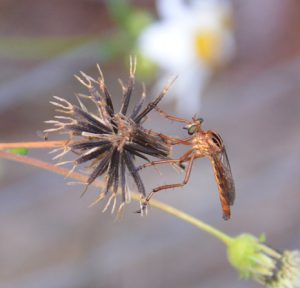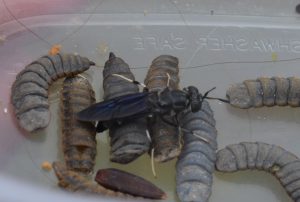
By Les Harrison
Wakulla County Extension Director
The summer of 2017 has been a good season for the insect population. There has been plenty to eat and Wakulla County has provided an exceptionally hospitable environment for these six legged residents.
It is difficult to step outside without encountering one of these creatures which walks, crawls or fliess. Insects buzzing in the air could be mosquitos, yellowflies, horseflies, houseflies, or some others.
The housefly, Musca domestica, is the most common domestic fly in Wakulla County and just about everywhere else on the planet. It accounts for about 90 percent of all flies in areas populated with human.
It has the notoriety of being one of the most widely distributed insects and is universally loathed. The housefly is considered a disease carrying pest which can be the vector for some serious bacterial infections because of its hygiene.
Given its reputation almost any insect which is labelled a fly becomes an immediate target for annihilation. There is a whole industry which produces flyswatters, flypaper, and fly baits and is committed to the wholesale destruction of the fly.
In Wakulla County the housefly has two insect cousins which have many of the same undesirable traits and disgusting personal habits, but a few positive attributes which warrant consideration for a pardon from immediate destruction. The soldier fly and the robber fly are not nearly as well known, but frequent many of the same locales as the housefly.
The scientific name for the soldier fly, Stratiomyidae, is derived from the Greek word for soldier. Variations of this insect are also found in Europe, too, where the Germans refer to it as an armed fly.
The soldier fly’s appearance is somewhat wasp-like which is considered a form of defensive mimicry, confusing potential predators into believing a sting will accompany any attempt to convert this vermin into a meal.

They are identified with black and yellow or sometimes metallic green markings. The soldier flies are often seen in their inactive state which is usually resting with their wings placed one above the other over the abdomen.
Soldier fly larvae are found in varying environments, most commonly in damp soil, sod, under bark, in animal manures, compost and in swamps. The larvae are mainly scavengers, consuming the organic scraps and castoffs of other animals.
Like many scavengers, their importance is in converting waste products into usable form for plants. The larvae are dark earth tone and may be confused with leaf litter, until they wiggle.
Adults usually are found near the larval habitats. They have distinctive three segment antennae and have a maximum length of about three fourths of an inch.
The adult soldier flies sustain themselves on wildflower nectar, which is easy to locate most of the year in north Florida. The remainder of their short lives is committed to finding the ideal site for their eggs.
The robber fly is slightly smaller than the soldier fly. It too has antennae with three segments, but its behavior is quite different.
They are tiny, but aggressive predators which attack and feed on a long list of insects and spiders. If the usual prey is in short supply, they will feed on each other.
The robber fly bayonets its victims it with its short, strong beak or proboscis. The target is injected with saliva containing a neurotoxin to immobilize it and digestive enzymes.
The unlucky insect or spider is quickly paralyzed as the robber fly’s venom liquefies its internal structure so it can slurp down its meal. The liquefied material is syphoned through the robber fly’s proboscis, and then the search for a new quarry begins. Luckily, humans are not usually on the menu.
Even though these aerial irritants are can be a nuisance now, the first sign of cold weather will send them into a winter sleep. The spring of 2018 will see them return, as they all ways have since before recorded history.
To learn more about flies in Wakulla County, visit the UF/IFAS Wakulla County website at https://blogs.ifas.ufl.edu/wakullaco or call 850-926-3931.
 0
0
